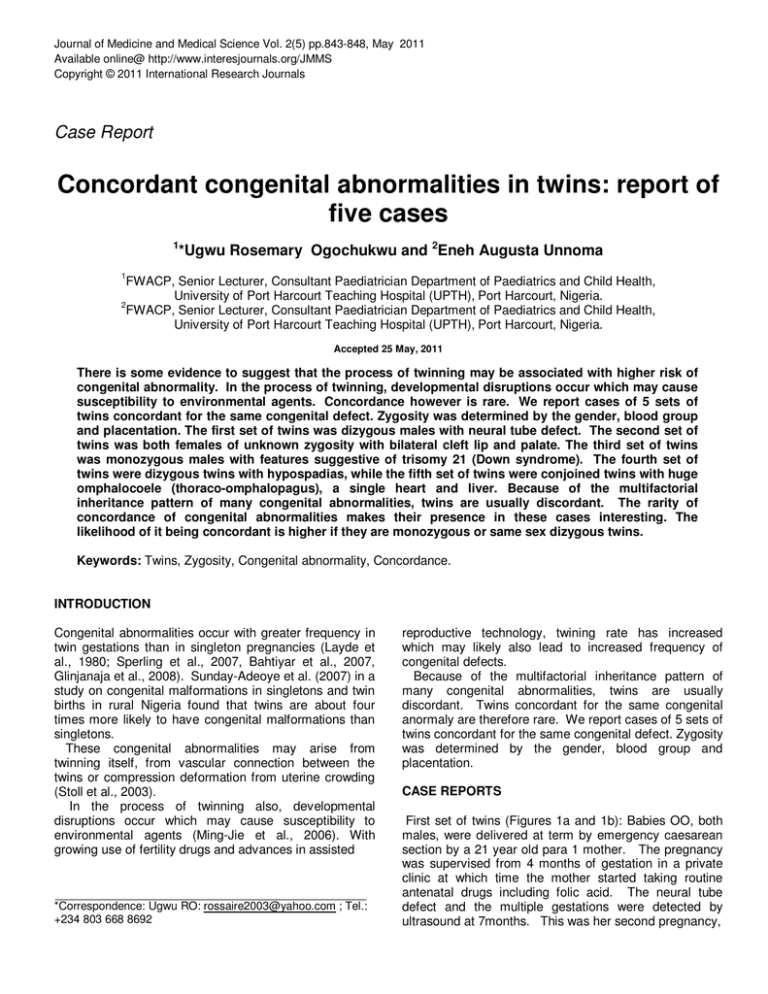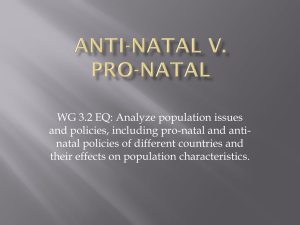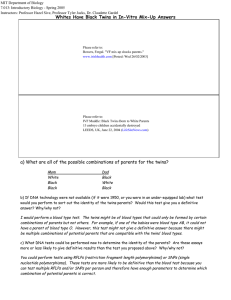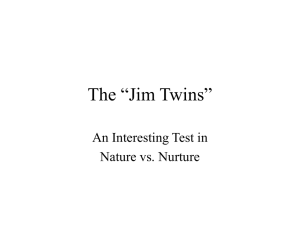Document 14233714
advertisement

Journal of Medicine and Medical Science Vol. 2(5) pp.843-848, May 2011 Available online@ http://www.interesjournals.org/JMMS Copyright © 2011 International Research Journals Case Report Concordant congenital abnormalities in twins: report of five cases 1 *Ugwu Rosemary Ogochukwu and 2Eneh Augusta Unnoma 1 FWACP, Senior Lecturer, Consultant Paediatrician Department of Paediatrics and Child Health, University of Port Harcourt Teaching Hospital (UPTH), Port Harcourt, Nigeria. 2 FWACP, Senior Lecturer, Consultant Paediatrician Department of Paediatrics and Child Health, University of Port Harcourt Teaching Hospital (UPTH), Port Harcourt, Nigeria. Accepted 25 May, 2011 There is some evidence to suggest that the process of twinning may be associated with higher risk of congenital abnormality. In the process of twinning, developmental disruptions occur which may cause susceptibility to environmental agents. Concordance however is rare. We report cases of 5 sets of twins concordant for the same congenital defect. Zygosity was determined by the gender, blood group and placentation. The first set of twins was dizygous males with neural tube defect. The second set of twins was both females of unknown zygosity with bilateral cleft lip and palate. The third set of twins was monozygous males with features suggestive of trisomy 21 (Down syndrome). The fourth set of twins were dizygous twins with hypospadias, while the fifth set of twins were conjoined twins with huge omphalocoele (thoraco-omphalopagus), a single heart and liver. Because of the multifactorial inheritance pattern of many congenital abnormalities, twins are usually discordant. The rarity of concordance of congenital abnormalities makes their presence in these cases interesting. The likelihood of it being concordant is higher if they are monozygous or same sex dizygous twins. Keywords: Twins, Zygosity, Congenital abnormality, Concordance. INTRODUCTION Congenital abnormalities occur with greater frequency in twin gestations than in singleton pregnancies (Layde et al., 1980; Sperling et al., 2007, Bahtiyar et al., 2007, Glinjanaja et al., 2008). Sunday-Adeoye et al. (2007) in a study on congenital malformations in singletons and twin births in rural Nigeria found that twins are about four times more likely to have congenital malformations than singletons. These congenital abnormalities may arise from twinning itself, from vascular connection between the twins or compression deformation from uterine crowding (Stoll et al., 2003). In the process of twinning also, developmental disruptions occur which may cause susceptibility to environmental agents (Ming-Jie et al., 2006). With growing use of fertility drugs and advances in assisted *Correspondence: Ugwu RO: rossaire2003@yahoo.com ; Tel.: +234 803 668 8692 reproductive technology, twining rate has increased which may likely also lead to increased frequency of congenital defects. Because of the multifactorial inheritance pattern of many congenital abnormalities, twins are usually discordant. Twins concordant for the same congenital anormaly are therefore rare. We report cases of 5 sets of twins concordant for the same congenital defect. Zygosity was determined by the gender, blood group and placentation. CASE REPORTS First set of twins (Figures 1a and 1b): Babies OO, both males, were delivered at term by emergency caesarean section by a 21 year old para 1 mother. The pregnancy was supervised from 4 months of gestation in a private clinic at which time the mother started taking routine antenatal drugs including folic acid. The neural tube defect and the multiple gestations were detected by ultrasound at 7months. This was her second pregnancy, 844 J. Med. Med. Sci. a b Figure 1a and 1b. Babies OO with myelomeningocoele. Note the increased head size of twin 1 the first pregnancy having ended in a spontaneous abortion at 7weeks of gestation (2 months before the index pregnancy). At birth the twins had different placenta and separate chorions (dichorionic) and were considered to be same sex dizygous twins. The first twin weighed 2700g with length of 47cm and occipito-frontal circumference (OFC) of 39cm while the second twin weighed 2400g and had a length of 44cm and OFC of 34cm. Twin one had a cystic swelling between the eleventh thoracic vertebra and the third sacral segment measuring 12cm x10cm with an ulcerated granulating surface. Twin two had a similar but smaller cystic swelling between the third lumbar vertebra and the second sacral segment and measuring 8cm x 5cm. Both twins had bilateral talipes equinovarus deformity, urinary and fecal incontinence and bilateral flaccid paralysis in the lower limbs with a sensory level below the umbilicus (twin 1) and below the knee (twin 2). Twin one in addition had a grade 3 pansystolic murmur of a ventriculo-septal defect which was confirmed by echocardiography. Transfontannele ultrasonography in twin 1 showed dilation of all the ventricles with thining of the cortical mantle. Their blood groups were O+ve. Although twin 2 was deemed eligible for surgery, parents declined and took both of them away. Second set of twins (Figure 2): Babies RO, both females were delivered by a 22-year old woman in a traditional birth attendant (TBA) by spontaneous vaginal at 28 weeks gestation. The mother is a known epileptic and has been on anticonvulsants drugs. Zygosity could not be determined as there was no reliable information on placentation, however both were blood group A Rhesus D positive. The first twin weighed 1450g and had a length of 45cm and OFC of 28cm while the second twin weighed 1200g with a length of 44cm and OFC of 27cm. Both twins had bilateral cleft lip and palate. Twin 2 also had ventriculo-septal heart defect confirmed by echocardiography. Both died at 4 days and 2 days respectively from overwhelming septicemia. Third set of twins: Babies EI, both males were delivered to a 41 year old elderly primp after 10 years infertility at 35 weeks gestation by emergency caesarean section due to severe pregnancy induced hypertension in the mother. The mother took fertility drugs (clomiphene citrate) before conception. She registered for antenatal care at 30 weeks gestation. Ultrasound scan done at 32 weeks revealed twin gestation. Both twins shared a single placentae and chorion (monozygotic) and weighed 1450g and 2000g respectively. At birth, both had several stigmata suggestive of trisomy 21 (floppy, prominent epicanthic folds, low set ears, depressed nasal bridge, flat occiput, microcephaly, protruding tongue and a single st nd palmar crease on the right (1 twin) and on the left (2 twin). Their blood group was O Rhesus D positive. Both twins died on the 4th and 5th day of life respectively from complications of severe birth asphyxia. Chromosomal studies could not be done as this was not available. Fourth set of twins (Figures 3a and 3b) were both males who were delivered at term by elective caesarean section at 38 weeks gestation after successful invitro fertilization (IVF) to a 38 year old primigravida. Each twin had a separate placenta and chorion (dizygous) and weighed 2700g and 2500g respectively. Twin one had penoscrotal hypospadias while twin two had glanular hypospadias. Both are awaiting corrective surgery. Their blood groups were O Rhesus D positive and B Rhesus D positive respectively. Fifth set of twins (Figures 4a, 4b, and 4c): Babies YT both female cojoined twins were delivered by a 25 year old para 2 woman after 8 years of subfertility by elective Ugwu and Eneh 845 Figure 2. Babies RO showing bilateral cleft lip and palate Figure 3. Penoscrotal hypospadias in twin 1 and glanular hypospadias in twin 2 caesarean section. She denies use of any fertility drugs. The twins who were monoamniotic monochorionic with a single placenta were joined from the lower thorax to the upper abdomen with an omphalocoele major (thoracoomphalopagus). They had a single umbilical cord. Their combined weight was 4700g and both were blood group O Rhesus positive. Magnetic resonance imaging and computerized tomography scan showed that they shared a single heart and a common liver. Both died on the 68th day of life reaching a combined weight of 6800kg while awaiting decision on separation. Autopsy findings showed that each twin had a separate oesophagus and stomach, but they shared a common pancreas. The infants shared a common tubular 4-chambered heart with separate great vessels entering and leaving the heart. They also shared a single liver but had separate 846 J. Med. Med. Sci. A B C Figure 4. A. Showing babies YT with thoraco-omphalopagus. Note the almost closed omphalocoele. B.Computed tomography scan of the chest showing the single tubular heart. C. Autopsy finding showing the single heart (short dark arrow) and single liver (long white arrow) gallbladders (each attached to the right and left lobes of the liver) and biliary ducts. The remainder of the small bowel and colon were separate and normally formed. DISCUSSION The frequency of spontaneous twinning varies from 1 in 30 to 1 in 150 pregnancies being highest among blacks and lowest in Asian races (Stoll et al., 2003). These can be monozygotic (MZ) or dizygotic (DZ). Monozygotic or identical twins occur when a single ovum is fertilized, so the twins possess an identical set of nuclear genes. DZ twins result from the fertilization of two separate ova. The difference in the incidence of twins is mainly due to dizygotic twins. The incidence of monozygotic twins (usually 3–5/1,000) is unaffected by racial or familial factors (Stoll et al., 2003). Zygosity of twins can be determined using several methods including quantitative fluorescent polymerase chain reaction (PCR) with short tandem repeats (STR) using amniotic fluid (Chen et al., 2000), DNA finger printing, tissue (HLA) typing or DNA probes using buccal smear (Stoll et al., 2003; Eufinger et al., 1993, Nylander, 2005; Chen et al., 2000 ). These sophisticated methods are however lacking in many developing countries. The placenta however provides the information in two-thirds of monozygotic twins in which there is one placenta or fused placenta but one chorion and one amnion, but may have a limitation in one third of monozygotic twins that are dichorionic and diamniotic (Stoll et al., 2003). Neural tube defects (NTD) are a group of disorders resulting from failure of the neural tube to close spontaneously between the third and fourth week of in utero development (Johnston et al., 2003). Because of its multifactorial inheritance pattern (multiple genetic and environmental factors), twins are usually discordant for this anomaly with only one co-twin affected. Some studies however have demonstrated concordance in the development of NTDs in identical twins. (Ertunc et al., Ugwu and Eneh 847 2005; Hansen et al., 1997; Putz et al., 1985). Only few studies have reported the occurrence of dizygotic twins concordant for NTD (Budhiraja et al., 2002; Das et al., 2003). Babies OO were same-sex dizygotic twins as they had different placentae and chorion. Cleft lip with or without cleft palate may exist as a single disorder or constitute part of a syndrome or chromosomal abnormality. Folic acid deficiency has been associated with malformations like neural tube defects, orofacial clefts (OFCs) and congenital heart defects (Bailey et al., 2005). The mother of babies RO had been on anticonvulsants for epilepsy which may have predisposed her to folic acid deficiency. Both twins had orofacial clefts and twin two in addition had a ventricular septal heart defect. The Danish study on cleft lip +/palate in twins found that the concordance rate was 60% in monozygotic twins and 10% in dizygotic twins (Christenson et al., 1993). It was not possible however to determine the zygosity of the twins by examination of the placenta, but their similar features, gender and blood group may suggest a monozygous status. The likelihood of having a twin or twins with Down syndrome is linked to a family history of twins, male gender, advanced maternal age or assisted pregnancies particularly ovarian stimulation (Buckley, 2003). The last three risk factors were found in the third set of twins. In monozygotic twins, both twins are usually affected (concordant) because they developed from one embryo, however in dizygotic twins, only one twin may be affected and the co-twin unaffected. In some cases where both unidentical twins have Down syndrome, the affected pregnancy was assisted using hormones (Buckley, 2003). Maternal screening for Down’s syndrome in twin pregnancies is fraught with difficulties, because the serum markers are high, fetoplacental products from the unaffected cotwin can mask the effect of an affected cotwin and invasive prenatal diagnosis and the selective abortion of the affected fetus may lead to the miscarriage of the unaffected twin. First trimester ultrasound for the measurement of nasal bone or nuchal translucency in combination with maternal serum markers (pregnancy associated plasma protein A and free â-hCG) are the most beneficial in the risk assessment of Down's syndrome for twin pregnancies (Spencer et al., 2003). These were however not done for the mother, because of late booking. Whether pregnancies following assisted reproductive technology (ART) increase the risk of congenital malformations have not been conclusively proven, however in case 4, both twins delivered after invitro fertilization had hypospadias. Other studies have showed an increased rate of congenital abnormalities in pregnancies conceived after invitro fertilization or intracytoplasmic sperm injection (IVF-ICSI) (Balci et al., 2008; Ben-Ami et al., 2005; Allen et al., 2006). It remains unclear if these increased risks are attributable to the underlying infertility, the process of twinning or use of assisted reproductive techniques. Conjoined twins are very rare and result from late monovular separation. After the thirteenth day of fertilization, twins who begin to split often do not make the full division. The result is what is commonly known as Siamese or conjoined twins. All conjoined twins are monozygotic. Although the incidence of conjoined twinning in Nigeria is unknown, there have been previous reports from Nigeria (Omokhodion et al., 2006; Owolabi et al., 2005, Usang et al., 2010). Because a lot of them share organs that make them incompatible with life, they may be still born and one third of those born alive share vital organs to the point that the two cannot be separated without harm or even death of one of the twins which would have been the case in babies YT as they shared the heart, liver and pancreas. Most conjoined twins are females as was the case in babies YT (Stoll et al., 2003; Omokhodion et al., 2006; Owolabi et al., 2005; Usang et al., 2010). The significantly increased incidence of congenital malformations observed in conjoined twins may be due to the late incomplete separation of the monozygotic embryo during embryogenesis (fission theory) or due to secondary union of two originally separate monovular embryonic discs (fusion theory) (Spencer, 2000). CONCLUSION Twins concordant for the same congenital abnormality is rare. Concordance rate however is higher in monozygotic twins and like-sex dizygotic twins ACKNOWLEDGEMENT The authors are grateful to Dr. Onubogu and the doctors and nurses in Special Care Baby Unit (SCBU) of the University of Port Harcourt Teaching Hospital. REFERENCES Allen VM, Wilson RD, Cheung A (2006). Pregnancy outcomes after assisted reproductive technology. J. Obstet. Gynaecol. Can., 28(3):220-50. Bahtiyar MO, Dulay AT, Weeks BP, Friedman AH, Copel JA (2007). Prevalence of Congenital Heart Defects in Monochorionic/Diamniotic Twin Gestations A Systematic Literature Review. J. Ultrasound. Med., 26:1491-1498. Bailey LB, Berry RJ (2005). Folic acid supplementation and the occurrence of congenital heart defects, orofacial clefts, multiple births, and miscarriage. Am. J. Clin. Nutri., 81(5):1213S-1217S. Balci S, Engiz O, Alikasifoglu M, Esinler I, Sinan-Beksac M (2008). Association of Assisted Reproductive Technology with Twinning and Congenital Anomalies. Indian J. Pediatr., 75(6):638 - 640. 848 J. Med. Med. Sci. Ben-Ami I, Vaknin Z, Reish O, Sherman D, Herman A, Maymon R (2005). Is there an increased rate of anencephaly in twins? Prenat. Diagn. 25(11):1007-1010. Buckley SJ (2003). How often are children with Down syndrome twins? Down Syndrome News and Update. 3(1);10-10. Available at www.down-syndrome.org/updates/207/. Budhiraja S, Dahiya P, Ghei M, Gathwala G (2002). Neural tube defect in dizygotic twins. Pediatr Surg. Int., 18:211-212. Chen CP, Chern SR, Wang W (2000). Rapid determination of zygosity and common aneuploides from amniotic fluid cells using quantitative fluorescent polymerase chain reaction following genetic amniocentesis in multiple gestation. Human Reproduction. 15(4):929-934. Christensen K, Fogh-Anderson P (1993). Cleft lip(+/- cleft palate) in Danish twins, 1970-1990. Am. J. Med. Genet., 47(6):910-916. Das G, Aggarwal A, Faridi MM(2003). Dizygotic twins with myelomeningocoele. Indian J. Pediatr., 70(3):265-267. Ertunc D, Tok EC, Kaplanoglu M, Polat A, Aras N, Evruke C (2005). Concordant occipital encephalocoele in monoamniotic twins. J. Perinat. Med., 33(4):357-359. Eufinger H, Rand S, Scholz W, Machtens E(1993). Clefts of the lip and palate in twins: use of DNA fingerprinting for zygosity determination. Cleft Palate Craniofac J. 30(6):564-568. Glinianaia SV,Rankin J, Wright C(2008). Congenital anomalies in twins: a register-based study. Human Reproduction. 23(6):1306-1311 Hansen LM, Donnenfeld AE(1997). Concordant anencephaly in monoamniotic twins and an analysis of maternal serum markers. Prenat. Diagn. 17(5):471-473. Johnston MV, Kinsman S(2003). Congenital anomalies of the central nervous system-neural tube defect (dysraphism). In: Behrman RE, th Kliegman RM, Jenson HB (eds) Nelson Textbook of Pediatrics 17 ed. WB Saunders Philadelphia.1983-1986. Layde PM, Erickson JD, Falek A, McCarthy BJ (1980). Congental malformation in twins. Am. J. Hum. Genet., 32(1):69-78. Ming-Jie Y, Cheng-Hwai T, Jen-Yu T, Ching-Ying H (2006). Determination of twin zygosity using a commercially available STR analysis of 15 unlinked loci and the gender-determining marker amelogenin - a preliminary report. Human Reproduction. 21(8):21752179. Nylander PPS (2005). The determination of zygosity—a study of 608 pairs of twins born in Aberdeen. BJOG. 77(6): 506-510. Omokhodion SI, Ladipo JK, Odebode TO, Ajao OG, Famewo CE, Lagundoye SB, Sanusi A, Gbadegesin RA (2001). The Ibadan conjoined twins: a report of omphalopagus twins and a review of cases reported in Nigeria over 60 years. Ann. Trop. Paediatr., 21(3):263-270. Owolobi AT, Oseni SB, Sowande OA, Adejuyigbe O, Komolafe EO, Adetiloye VA, Komolafe A (2005). Dicephalus dibrachius dipus conjoined twins in a triplet pregnancy. Trop. J. Obstet. Gynaecol., 22:87-88. Putz B, Rehder H (1985). Anencephaly in one monoamnioticmonochorionic twin and encephalocoele in the other, Am. J. Med. Genet., 21(4):631-635. Spencer K, Nicolaides KH (2003). Screening for trisomy 21 in twins using first trimester ultrasound and maternal serum biochemistry in a one-stop clinic: a review of three years experience. BJOG. 110(3):276-280. Spencer R (2000). Theoritical and analytical embryology of conjoined twins part 1: embryogenesis. Clin. Anat. 13(1):36-53 Sperling L, Kiil, C, Larsen L. U, Brocks V, Wojdemann K. R, Qvist I, Schwartz M, Jørgensen C, Espersen G, Skajaa K, Bang J, Tabor A (2007). Detection of chromosomal abnormalities, congenital abnormalities and transfusion syndrome in twins. Ultrasound in Obstetrics and Gynaecology. 29(5):517-526. Stoll BJ, Kliegman RM (2003). The high risk infant. In: Behrman RE, th Kliegman RM, Jenson HB (eds) Nelson Textbook of Pediatrics 17 ed. WB Saunders Philadelphia 2003: 1608-1648. Sunday-Adeoye I, Okonta PI, Egwuatu VE (2007). Congenital malformations in singleton and twin births in rural Nigeria. Niger Postgrad. Med. J., 14(4):277-280. Usang UE, Babatunde J Olasode BJ, Archibong AE, Udo JJ, Eduwem D-A U (2010). Dicephalus parapagus conjoined twins discordant for anencephaly: a case report. JMCR. 4:38. Also available at http://www.jmedicalcasereports.com/content/4/1/38






